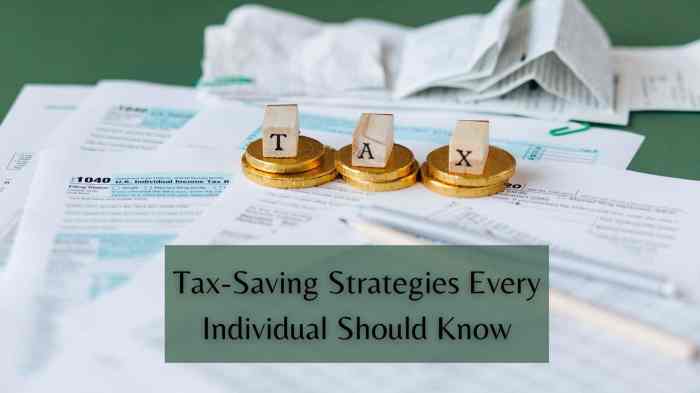Looking for ways to save on your taxes? Dive into the world of tax saving strategies, where we explore tips and tricks to help you reduce your tax liabilities and keep more money in your pocket.
Overview of Tax Saving Strategies
Tax saving strategies are essential techniques used to minimize the amount of tax an individual owes to the government. By implementing these strategies effectively, individuals can legally reduce their tax liabilities and keep more money in their pockets.
One common tax saving strategy is contributing to retirement accounts such as a 401(k) or IRA. By making contributions to these accounts, individuals can lower their taxable income for the year, ultimately reducing the amount of taxes they owe. Another strategy is taking advantage of tax deductions, such as those for mortgage interest, charitable donations, or medical expenses.
Examples of Common Tax Saving Strategies
- Maximizing contributions to retirement accounts
- Utilizing tax deductions for mortgage interest
- Donating to charitable organizations to qualify for tax deductions
- Investing in tax-deferred or tax-exempt accounts
Retirement Account Contributions
Contributing to retirement accounts is a smart way to save on taxes while securing your financial future. By setting aside money in these accounts, you can reduce your taxable income and potentially lower your overall tax bill.
Types of Retirement Accounts
- Traditional IRA: Contributions are tax-deductible, and earnings grow tax-deferred until withdrawal.
- Roth IRA: Contributions are made with after-tax dollars, but withdrawals in retirement are tax-free.
- 401(k): Employer-sponsored retirement account where contributions are made pre-tax, reducing taxable income.
Maximizing Tax Savings
One way to maximize tax savings through retirement account contributions is to contribute the maximum allowable amount each year. For example, in 2021, you can contribute up to $19,500 to a 401(k) and $6,000 to an IRA (or $7,000 if you’re over 50).
Itemized Deductions
When it comes to lowering your taxable income, itemized deductions can be a powerful tool to maximize tax savings. By deducting eligible expenses, you can reduce the amount of income that is subject to taxes, ultimately lowering your overall tax bill.
Common Expenses for Itemized Deductions
- Mortgage interest
- Property taxes
- State and local income taxes
- Charitable contributions
- Medical expenses (above a certain threshold)
- Unreimbursed work-related expenses
Remember, you can only choose to itemize deductions if the total amount of your eligible expenses exceeds the standard deduction set by the IRS.
Tips for Optimizing Itemized Deductions
- Keep track of all expenses throughout the year to ensure you don’t miss any deductions.
- Consider bundling deductions in certain years to exceed the standard deduction threshold.
- Consult with a tax professional to ensure you are maximizing your deductions within the legal limits.
Tax-Efficient Investments: Tax Saving Strategies

Investing in tax-efficient vehicles is crucial for maximizing long-term savings and minimizing tax liabilities. By choosing investments that offer tax advantages, individuals can reduce their overall tax burden while growing their wealth over time.
Different Investment Options
- 401(k) and IRA Accounts: Contributions to traditional 401(k) and IRA accounts are tax-deductible, allowing individuals to lower their taxable income while saving for retirement.
- Roth IRA: While contributions to Roth IRA accounts are made with after-tax money, qualified withdrawals in retirement are tax-free, providing tax-free growth potential.
- Municipal Bonds: Interest earned from municipal bonds is typically exempt from federal taxes, making them a tax-efficient investment option for individuals in higher tax brackets.
- Index Funds: Index funds have lower turnover rates compared to actively managed funds, resulting in fewer capital gains distributions and tax consequences for investors.
Examples of Tax-Efficient Investments and Impact
- 401(k) Contributions: By contributing to a 401(k) account, individuals can reduce their taxable income, potentially lowering their tax bracket and saving money on taxes each year.
- Roth IRA Growth: Investing in a Roth IRA allows individuals to enjoy tax-free growth on their investments, meaning they won’t owe taxes on capital gains or dividends when they withdraw the funds in retirement.
- Municipal Bonds: Investing in municipal bonds can provide a steady stream of tax-free income, helping individuals diversify their portfolio while minimizing tax liabilities.
- Index Fund Savings: Choosing index funds over actively managed funds can result in lower tax implications due to reduced turnover and capital gains distributions, keeping more money in investors’ pockets.
Tax Credits
Tax credits are direct reductions in the amount of taxes you owe. Unlike deductions that reduce the amount of your income subject to taxes, tax credits reduce your actual tax liability dollar for dollar.
Common Tax Credits
- The Earned Income Tax Credit (EITC): A credit for low to moderate-income individuals and families, particularly those with children.
- Child Tax Credit: Provides a credit for each qualifying child under the age of 17.
- American Opportunity Credit: Helps offset the costs of higher education expenses.
Maximizing Tax Credits
Make sure to review all available tax credits for which you qualify to maximize your savings.
- Keep accurate records of expenses that qualify for tax credits.
- Consider timing certain expenses to maximize the credit amount in a given tax year.
- Consult with a tax professional to ensure you are taking advantage of all eligible credits.
Charitable Giving

When it comes to charitable giving, not only are you making a positive impact on society, but you can also benefit from tax advantages. By donating to qualified charities, you can reduce your taxable income and potentially lower your overall tax bill.
Tax Benefits of Charitable Donations
- When you make charitable donations, you may be eligible to deduct the amount of your donation from your taxable income. This can result in lower taxes owed at the end of the year.
- For donations of cash or property, you can typically deduct up to 60% of your adjusted gross income. For donations to certain types of organizations, such as private foundations, the limit may be lower at 30%.
- Donating appreciated assets, such as stocks or real estate, can also provide additional tax benefits. You can avoid capital gains taxes on the appreciation while still claiming a deduction for the full fair market value of the asset.
Rules and Limitations for Tax Deductions
- In order to claim a tax deduction for charitable donations, you must itemize your deductions on your tax return. This means forgoing the standard deduction, so it’s important to calculate whether your total itemized deductions exceed the standard deduction amount.
- Keep in mind that there are specific rules and limitations for different types of donations. For example, if you receive something in return for your donation, such as a gift or event tickets, you may need to reduce the amount you can deduct.
- Documentation is key when it comes to claiming deductions for charitable giving. Make sure to keep records of your donations, including receipts from the charity, bank statements, and any written acknowledgments of your contribution.
Tips for Maximizing Tax Savings, Tax saving strategies
- Consider bundling your donations by making larger contributions in a single year to exceed the standard deduction threshold. This can help you itemize your deductions in that year and take advantage of the tax benefits.
- Research and donate to charities that align with causes you care about, as this can make the giving experience more meaningful and fulfilling.
- Explore donor-advised funds as a way to consolidate your charitable giving and potentially receive immediate tax benefits while distributing donations to charities over time.



